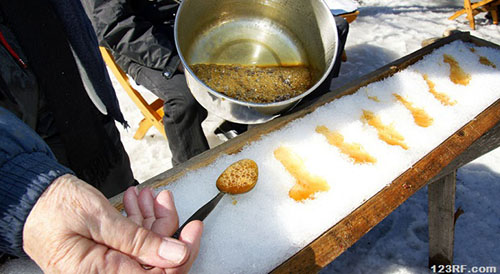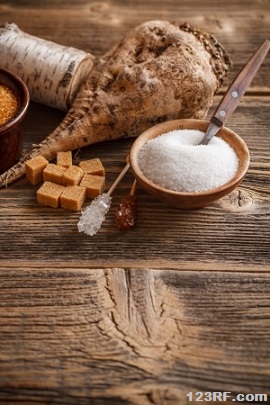One of the best bartering products when SHTF is undoubtedly going to be sugar. It will also be a great product to have in order to make treats that boost morale and lend a sense of normalcy to life, which will be crucial to survival.

The problem is that storing large quantities of sugar is a challenge. It’s bulky, takes up a ton of space, and is a bug magnet.
Even if you stockpile the sweetness, you will still eventually run out, but what if you knew how to make your own? It’s really not that difficult and there are a couple of ways that you can do it. For that matter, as part of your homesteading way of life, you could make your own just so that you know where it’s coming from.
Today we’re going to tell you how to make sugar at home. As a matter of fact, we’re going to teach you about two types.
Unless you’re fortunate enough to live in a tropical climate and have a ton of expensive equipment, you won’t be able to grow sugar cane, the crop that yields about 70% of table sugar in the US. You can, however, grow sugar beets, which is used to produce the other 30% of the sugar that you buy. You can also make maple sugar from maple syrup.
Back To Basics: How To Make Sugar At Home
How to Make Beet Sugar
Not surprisingly, beet sugar is made from sugar beets. These aren’t the same as the red or white bulbous beets that you’ve eaten as a dinner side or with pickled eggs; sugar beets actually look more like a parsnip or daikon than they do their sister beets. They’re elongated and have a similar coloring to white potatoes and sugar beets grow well in a variety of climates just like all beets do.
Sugar beets were originally grown to feed livestock but aren’t really fit for human consumption. Here’s one of our favorite things about sugar beets – after you make the sugar, you can still use the leftover meat of the beet as a hot or cold mash for your livestock. No waste!
Beet sugar is super-easy to make, too. No special equipment is required and it doesn’t take a long time to do it.
 Scrub your beets to get all dirt and debris off of them.
Scrub your beets to get all dirt and debris off of them.- Thinly slice, dice or shred the beets and place them in a pot.
- Add just enough water to cover the beets.
- Heat to a boil then simmer long enough for the beets to become tender and soft.
- Remove from heat and strain the beet pulp out of the juice using cheesecloth.
- Return the syrup to the pot.
- Hold the cheesecloth full of pulp over the pot and squeeze as much water as possible out.
- Simmer until it becomes thick, honey-like syrup, stirring frequently, then remove from heat.
- Place in a storage container and allow to cool.
- As it cools, the sugar will crystalize. Remove crystals and smash into a powder with your fingers so that it looks like table sugar.
- Store and use just like you would regular sugar.
See how easy it is to make beet sugar at home?
Just FYI, you can expect to get about 17% of your original beet weight in sugar. To do the math for you, you’ll need about 10 pounds of beets to yield 1.7 pounds of sugar.
How to Make Maple Sugar at Home
Maple sugar is deliciously reminiscent of the syrup that it’s made from; it has that beautiful, sort of smoky maple flavor. Chances are that you’ve had maple sugar at least once in your life. It’s frequently sold as candy in the shape of maple leaves.
Maple sugar is great for baking, eating, or just adding to your tea. Once you try it, you’ll be hooked. You don’t need anything too specialized but you will need a candy thermometer and a heavy-bottomed pan.
- Start with about 3 gallons of pure, organic maple syrup.
- Heat on medium high until the syrup reaches 290-300 degrees, which is between soft crack and hard crack stages. If the syrup starts to overflow, just reduce heat a bit then turn it back up after the foam settles.
- Remove from heat and stir vigorously for about 5 minutes.
- Pour into a heat-resistant container; it’s going to be extremely hot!
- Allow to cool completely.
- Break into chunks and grate into a powder.
- Store as you would standard sugar.
One quart of syrup will yield about 2 pounds of granulated sugar. If you live in an area with maple trees, you can draw the sap directly from the trees and make your own syrup. Making maple sugar is a great skill to have for survival because it’s easy and requires very little specialized equipment other than a tap for the tree.
Just FYI, darker maple syrups tend to yield a moister sugar than lighter-colored syrups do. Since maple trees are tapped in the spring when the sap is running, you need a tremendous amount of sap, about 40 gallons, just to make 1 gallon of good syrup. Just to give you an idea, an average tree yields about 3-4 gallons per day and a little over 13 gallons per season, total.
Because you can tap the tree without seriously damaging it, maple syrup and maple sugar are both wonderfully sustainable foods that can be used in a number of ways by a survivalist. It’s also delicious to eat even when things are going wonderfully!
It’s easy to make both beet sugar and maple sugar at home and they both have their uses. Maple sugar does taste differently so you may wish to use it when you’re looking specifically for that flavor profile. Beet sugar tastes just like plain white sugar so you can use it just as you would cane sugar.
When SHTF, sugar is going to be a primo product because of the luxury of the crop. Those who have it or, even better, know how to make it, will certainly benefit from both the time and effort. Plus, you won’t have to worry about drinking your tea unsweetened no matter how bad things get. In post-disaster times, a little bit of comfort or luxury may very well go a long way.
If you have any other hints or suggestions, please feel free to share them in the comments section below!
This article has been written by Theresa Crouse for Survivopedia.
Want to be as self-sufficient as possible? Want to master all the lost skills our grandfathers had? Then you really need this amazing step-by-step guide. It is called The Lost Ways and it contains all the knowledge of our forefathers.
Here’s just a glimpse of what you’ll find in The Lost Ways:
From Ruff Simons, an old west history expert and former deputy, you’ll learn the techniques and methods used by the wise sheriffs from the frontiers to defend an entire village despite being outnumbered and outgunned by gangs of robbers and bandits, and how you can use their wisdom to defend your home against looters when you’ll be surrounded.
Native American ERIK BAINBRIDGE – who took part in the reconstruction of the native village of Kule Loklo in California, will show you how Native Americans build the subterranean roundhouse, an underground house that today will serve you as a storm shelter, a perfectly camouflaged hideout, or a bunker. It can easily shelter three to four families, so how will you feel if, when all hell breaks loose, you’ll be able to call all your loved ones and offer them guidance and shelter? Besides that, the subterranean roundhouse makes an awesome root cellar where you can keep all your food and water reserves year-round.
From Shannon Azares you’ll learn how sailors from the XVII century preserved water in their ships for months on end, even years and how you can use this method to preserve clean water for your family cost-free.
Mike Searson – who is a Firearm and Old West history expert – will show you what to do when there is no more ammo to be had, how people who wandered the West managed to hunt eight deer with six bullets, and why their supply of ammo never ran out. Remember the panic buying in the first half of 2013? That was nothing compared to what’s going to precede the collapse.
From Susan Morrow, an ex-science teacher and chemist, you’ll master “The Art of Poultice.” She says, “If you really explore the ingredients from which our forefathers made poultices, you’ll be totally surprised by the similarities with modern medicines.” Well…how would you feel in a crisis to be the only one from the group knowledgeable about this lost skill? When there are no more antibiotics, people will turn to you to save their ill children’s lives.
And believe it or not, this is not all…
Table Of Contents:
Making Your Own Beverages: Beer to Stronger Stuff
Ginger Beer: Making Soda the Old Fashioned Way
How North American Indians and Early Pioneers Made Pemmican
Spycraft: Military Correspondence During The 1700’s to 1900’s
Wild West Guns for SHTF and a Guide to Rolling Your Own Ammo
How Our Forefathers Built Their Sawmills, Grain Mills,and Stamping Mills
How Our Ancestors Made Herbal Poultice to Heal Their Wounds
What Our Ancestors Were Foraging For? or How to Wildcraft Your Table
How Our Ancestors Navigated Without Using a GPS System
How Our Forefathers Made Knives
How Our Forefathers Made Snow shoes for Survival
How North California Native Americans Built Their Semi-subterranean Roundhouses
Our Ancestors’Guide to Root Cellars
Good Old Fashioned Cooking on an Open Flame
Learning from Our Ancestors How to Preserve Water
Learning from Our Ancestors How to Take Care of Our Hygiene When There Isn’t Anything to Buy
How and Why I Prefer to Make Soap with Modern Ingredients
Temporarily Installing a Wood-Burning Stove during Emergencies
Making Traditional and Survival Bark Bread…….
Trapping in Winter for Beaver and Muskrat Just like Our Forefathers Did
How to Make a Smokehouse and Smoke Fish
Survival Lessons From The Donner Party
Get your paperback copy HERE
CHECK OUR survival and prepping solutions
If you found this article useful, please like our Facebook page and stay up to date with the latest articles.
WHAT TO READ NEXT:
HOW TO MAKE YOUR OWN BACON (STEP BY STEP GUIDE)
A RETURN TO THE OLD PATHS: HOW TO MAKE PEMMICAN LIKE THE NATIVE AMERICANS
20 LOST RECIPES FROM THE PIONEERS: WHAT THEY COOKED ON THEIR JOURNEY WESTWARD
SEVEN CLASSIC GREAT DEPRESSION ERA RECIPES GRANDMA USED TO MAKE
POTTED MEAT: A LOST SKILL OF LONG TERM MEAT STORAGE
BACK TO BASICS: HOW TO MAKE AND PRESERVE LARD
THE BEST WAY TO STOCKPILE VEGETABLES OFF-GRID
OLD FASHIONED PRESERVING-GRANDPA’S RECIPE FOR CURED SMOKED HAM
HOW TO MAKE GUNPOWDER THE OLD FASHIONED WAY
SURVIVAL HERBAL RECIPES FROM OUR ANCESTORS
HOW TO PRESERVE MEAT FOR SURVIVAL LIKE OUR GRANDFATHERS
OTHER USEFUL RESOURCES:
The 3 Pioneer Survival Lessons We Should Learn
The Most Effective Home Defense Strategies
Old School Hacks for Off-Grid Living
The Medical Emergency Crash Course
The Smart, Easy Way to Food Independence
How to Survive the Coming 100 Years Long Drought
About Theresa Crouse
Theresa Crouse is a full-time writer currently living in central Florida. She was born and raised in the hills of West Virginia, where she learned to farm, hunt, fish, and live off the land from an early age. She prefers to live off the grid as much as possible and does her best to follow the “leave nothing behind but footprints” philosophy. For fun, she enjoys shooting, kayaking, tinkering on her car and motorcycle, and just about anything else that involves water, going fast, or the outdoors. You can send Theresa a message at editor [at] survivopedia.com.
